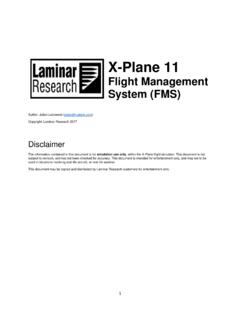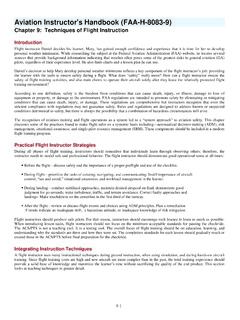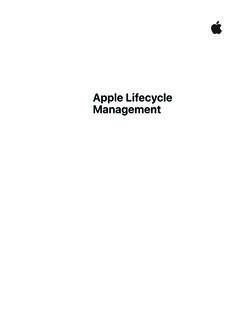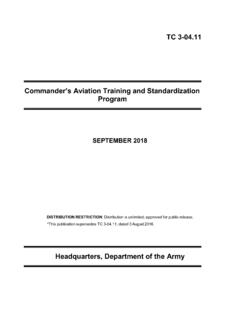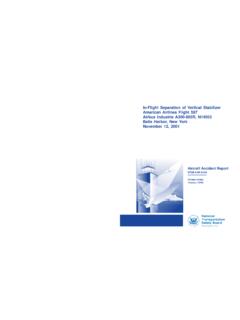Transcription of AC 120-71B - Standard Operating Procedures and Pilot ...
1 Department of Transportation Federal Aviation Administration Advisory Circular Subject: Standard Operating Procedures and Pilot Monitoring Duties for flight Deck Crewmembers Date: 1/10/17 AC No: 120-71B Initiated by: AFS-200 Change: This advisory circular (AC) provides guidance for the design, development, implementation, evaluation, and updating of Standard Operating Procedures (SOP), and for Pilot monitoring (PM) duties. SOPs are universally recognized as fundamental to safe aviation operations. Their importance cannot be overstated, especially in light of the advent of PM standards with respect to the use of increasingly modernized automated systems. This AC provides a process for developing Procedures that meet clear and specific requirements. Safe operations are founded on comprehensive SOPs made readily available within the manuals used by flight deck crewmembers. This AC also provides guidance on the definition and the training of PM duties and their integration into SOPs.
2 Although this AC is directed towards Title 14 of the Code of Federal Regulations (14 CFR) part 121 and part 135 air carriers, the Federal Aviation Administration (FAA) encourages all air carriers, aircraft operators, Pilot schools, and training centers to utilize this guidance. John Barbagallo Deputy Director, flight standards Service1/10/17 AC 120-71B CONTENTS Paragraph Page Chapter 1. Background Information .. 1-1 General .. 1-1 Cancellation .. 1-1 Summary of Changes .. 1-1 Terms and Definitions .. 1-2 Related 14 CFR Sections .. 1-2 Related Gudiance and Information .. 1-3 Chapter 2. Determining When Procedures Need to be Designed or Modified .. 2-1 Requirements for Procedures .. 2-1 Modifying OEM Procedures .. 2-1 Chapter 3. Creating a Procedure Development Process .. 3-1 Characteristics of Good Procedures .. 3-1 Collaborating for Effective SOPs .. 3-1 Resources to Develop SOPs .. 3 -1 Chapter 4. Writing Procedures .
3 4-1 General Guidelines .. 4-1 Information to Include .. 4-1 Avoid Visual Clutter .. 4-1 Use Plain Language .. 4-1 Use Short Sentences .. 4-1 Use Active 4-1 Write Steps as Imperatives .. 4-1 Organization .. 4-1 General Organization .. 4-1 Navigation and Place Keeping .. 4-1 Lists .. 4-1 References .. 4-2 Memory Items .. 4-2 Indices .. 4-2 iii 1/10/17 AC 120-71B Vocabulary .. 4- 2 Use Words Consistently .. 4- 2 Avoid Using Words with Multiple Common Meanings .. 4- 2 Use Abbreviations Carefully .. 4- 2 Numbers .. 4- 2 Use Arabic Numbers .. 4- 2 Include Units of Measurement .. 4- 2 Format .. 4- 2 Type Size .. 4- 2 Line Spacing .. 4- 3 Font.. 4- 3 Case.. 4- 3 Grouping.. 4- 3 Justification .. 4- 3 Line Length .. 4- 3 Place Keeping .. 4- 3 Title .. 4- 3 New 4- 3 Bullets and Numbering .. 4- 3 Continuation .. 4- 3 4- 3 Emphasis .. 4- 3 Typographical.
4 4- 4 Graphical .. 4- 4 Spatial .. 4- 4 Verbal .. 4- 4 Conditional Steps .. 4- 4 Complex Conditional Statements .. 4- 4 Waiting, Continuous Actions, Repeated Actions .. 4- 5 Cross-References .. 4- 5 Explicit Reference .. 4- 5 Version Control .. 4- 5 Warnings and Cautions .. 4- 5 iv 1/10/17 AC 120-71B Components of Warnings and Cautions.. 4-5 Placement .. 4-5 Chapter 5. Developing 5-1 General.. 5-1 Consistency .. 5-1 Type of List and Manner of Execution .. 5-1 Timing .. 5-1 Roles .. 5-2 Initiation Anchor .. 5-2 Completion Signal .. 5-2 Checklist 5-2 Methods for Managing Checklist Accomplishment .. 5-3 Single- Pilot Aircraft .. 5-3 Multi- Pilot 5-3 Interruptions .. 5-4 Representative Items.. 5 -4 Item Order .. 5-5 Phraseology .. 5-5 Common Errors That Occur When Using Checklists .. 5-5 Preventing Checklist Errors .. 5-6 Training Support Personnel .. 5-6 Restarting From the Beginning.
5 5-6 Cognitive Limitations .. 5-6 Checklist Error Prevention Tips .. 5-6 Chapter 6. Pilot Monitoring .. 6-1 General .. 6-1 Effective Monitoring .. 6-1 Challenges and Barriers to Effective Monitoring .. 6-1 Time Pressure .. 6-1 Lack of Feedback to pilots When Monitoring Lapses Occur .. 6-1 Design of SOPs .. 6-1 pilots Inadequate Mental Model of Autoflight System 6-2 v 1/10/17 AC 120-71B Training .. 6- 2 Pilot Performance .. 6- 2 Defining Pilot Monitoring Duties .. 6- 2 Operational Policies and Procedures .. 6- 3 Intervention Strategies .. 6- 3 What Intervention Strategies Should Include .. 6- 3 Human-to-Human Intervention .. 6- 3 Training for PM .. 6- 4 Incorporate Monitoring into SOPs .. 6- 5 Autoflight Considerations .. 6- 6 Autoflight Mode Confusion .. 6- 6 Autoflight Mode Awareness .. 6- 7 Appendix A. Related Guidance and Information.. A-1 vi 1/10/17 AC 120-71B CHAPTER 1. BACKGROUND INFORMATION General.
6 Standard Operating Procedures (SOP) are universally recognized as fundamental to safe aviation operations, yet accidents and incidents continue to occur as a direct result from, or related to, a failure by the flightcrew to follow SOPs, particularly during critical phases of flight . This advisory circular (AC) provides guidance for the design, development, implementation, evaluation, and updating of SOPs. It emphasizes that SOPs should be clear, comprehensive, and readily available within the manuals used by flight deck crewmembers. Although this AC is directed towards Title 14 of the Code of Federal Regulations (14 CFR) part 121 and part 135 air carriers, the FAA encourages all air carriers, aircraft operators, Pilot schools, and training centers to utilize this guidance. The basis for this guidance is contained in the related regulations and FAA guidance sections of this AC. This AC is not mandatory and does not constitute a regulation.
7 This AC describes an acceptable means, but not the only means, to design, develop, update, and use SOPs. Effective crew coordination and crew performance depend on the crew s having a shared mental model of each task. That mental model, in turn, is founded on SOPs. SOPs should serve to provide a consistent, standardized model of each task that must be performed by each crewmember during each phase of flight and during any reasonably anticipated abnormal, non-normal, or emergency situation. SOPs must be kept current and may be individually developed by the operator or by incorporating those Procedures found in their aircraft Operating manuals into their daily operations. Once established, the SOPs must be applied with consistency and uniformity throughout the operation. Implementation of any procedure as an SOP is most effective when: 1. The procedure is appropriate to the situation. 2. The procedure is practical to use. 3. Crewmembers understand the reasons for the procedure.
8 4. Pilot flying (PF) and Pilot monitoring (PM) duties are clearly delineated. 5. Effective training is conducted. 6. Adherence to the Standard is emphasized by flightcrews, and reinforced by instructors, check pilots , and managers alike. 7. Crewmembers are aware of the potential risks/hazards if SOPs are not followed. Cancellation. This AC cancels AC 120-71A, Standard Operating Procedures for flight Deck Crewmembers, dated February 27, 2003. Summary of Changes. Many changes have been made to improve clarity, accuracy, completeness, and consistency. Significant changes include adding regulatory 1- 1 1/10/17 AC 120-71B requirements contained in part 121 for PM and removing many of the examples previously found in the appendices. The stabilized approach criteria has been removed from this AC and can be found in AC 91-79A, Mitigating the Risks of a Runway Overrun Upon Landing (include Chg 1). Terms and Definitions. For the purpose of this AC, the following definitions and terms are provided: 1.
9 Checklist. A checklist is a tool to reduce the potential for flightcrew error in configuring the aircraft safely for various phases of flight , and for any malfunctions that may have occurred. 2. Crew Resource Management (CRM). The effective use of all available resources to achieve safe and efficient flight , to include human resources, hardware, and information. 3. Electronic Checklist. A checklist that is displayed to the flightcrew by means of an electronic device. 4. Flightpath. The aircraft trajectory and energy state, in flight . 5. Flightpath Management. flight deck planning, execution, and assurance of the guidance and control of the flightpath. 6. High Workload Environment. Any environment in which multiple demands on the flightcrew necessitate the prioritizing of work functions. For example, IFR operations below 10,000 feet during arrival or departure from a terminal area (including taxiing) are considered to be high workload environments.
10 7. Pilot Flying (PF). The Pilot who is controlling the path of the aircraft at any given time, in flight or on the ground. 8. Pilot Monitoring (PM). The PM monitors the aircraft state and system status, calls out any perceived or potential deviations from the intended flightpath, and intervenes if necessary. 9. Procedure. A logical progression of actions, decisions, or both in a sequence which is prescribed to achieve a specified objective. 10. Standard Operating Procedure (SOP). Written and tested Procedures that are applied uniformly and consistently within an operation and involve all aspects of flight operations, normal, abnormal, non-normal, and emergency. Related 14 CFR Sections. Part 91, and Part 121, , , , , , , , , and Part 125, Part 135, , , , and 1- 2 1/10/17 AC 120-71B Related Guidance and Information. Related FAA guidance and other reading material may be found in Appendix A. 1- 3 1/10/17 AC 120-71B CHAPTER 2.










